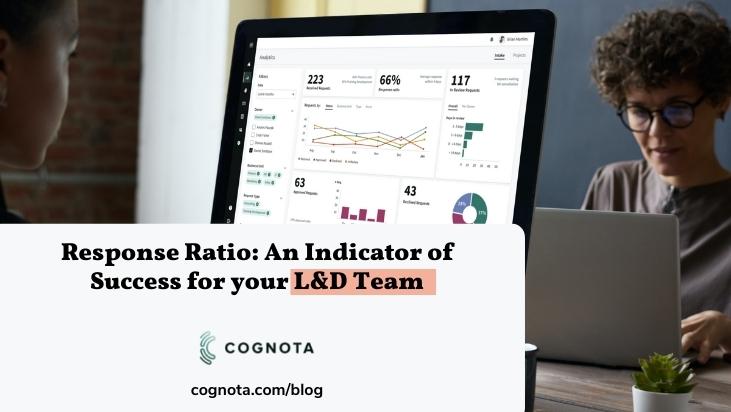Our Customer Success team shares insights on how keeping track and staying on top of your response ratio when actioning intake requests can create business impact.
An effective L&D team is crucial for the success of a business, and there are several benefits of having a dedicated L&D team in your organization from improved employee retention to a more productive workforce.
During the intake process, decisions that are vital to the future of the business are made by L&D teams, Most important, is the ability for your L&D team to assess, triage and action requests in a timely manner as this not only demonstrates an organization’s response to business needs but helps with stakeholder relationship management.
A key portion of our Insights tool is the ability to track your team’s percentage response ratio, and determine if it is on a par with team effort and expectations, which is why we provide you with a Response Ratio.
What is a Response Ratio? A Response Ratio is the ratio between your approved requests and the requests in review. It is a great indicator of your team’s effectiveness in actioning intake requests and gives you the ability to dive deeper into factors that might be impacting your entire intake process. Below, we’ve shared four reasons why staying on top of your response ratio is important.
- L&D Team Capacity: Knowing that your team has the ability to meet business needs can be the distinguishing factor between success and failure. In order to ensure that requests are moving down the pipeline, you need to know your team capacity in correlation to the volume of requests you are receiving from the business. A lower response ratio could indicate that your team is overwhelmed and they cannot take on additional work. This in turn disrupts the pace at which requests are actioned and impacts the development of L&D programs.
- Unclear Intake Process: The intake process is very crucial in ensuring that your L&D needs are met. Configuring the right set of discovery questions for stakeholders can determine if you would have a seamless and efficient review process. Poor communication means confusion on both sides. If your intake questions are not clear enough to gather the requirements or information needed for a request to be actioned, your L&D team may find themselves going back and forth with the requestor thereby delaying the entire review process and creating a backlog of requests. This ultimately results in a lower response ratio.
- Credibility: Your response ratio also speaks volume about the reputation of your business. Business needs are ever changing and L&D teams need to adapt and respond quickly. This implies making sure the right content is available at the right time, and not several months later. This quick delivery is vital to maintaining an organization’s reputation, and in a competitive landscape, if business needs are not addressed in a timely manner, your business risks losing credibility because the right tools are not available to build a productive workforce. A lower response ratio would give you an indication as to your team’s pace in actioning requests, and the necessary adjustments can be made to ensure there is no negative impact on the business.
- Triaging Request: Appropriately triaging requests is essential in speeding up the review process. This would ensure that your team knows which requests need to be waitlisted in order for higher priority needs to move down the funnel based on business impact. A lower response ratio could indicate that there is a prioritization challenge because your team isn’t able to determine what needs to move quickly. To address this, your team needs to develop a model for assessing and prioritizing requests by ensuring that you are able to capture the right information that makes it easier to identify what should be prioritized. Companies that follow this approach can experience significant reductions in cost because less-important activities and duplication of effort are eliminated thereby getting things to move down the line quickly.
As you can see, the response ratio is more than just a number, and when paired with analytical thinking, it can reveal a lot of insights related to the effectiveness of your L&D department. If you have any feedback, comments or experiences you would like to share, please feel free to reach out to us at support@cognota.com.




